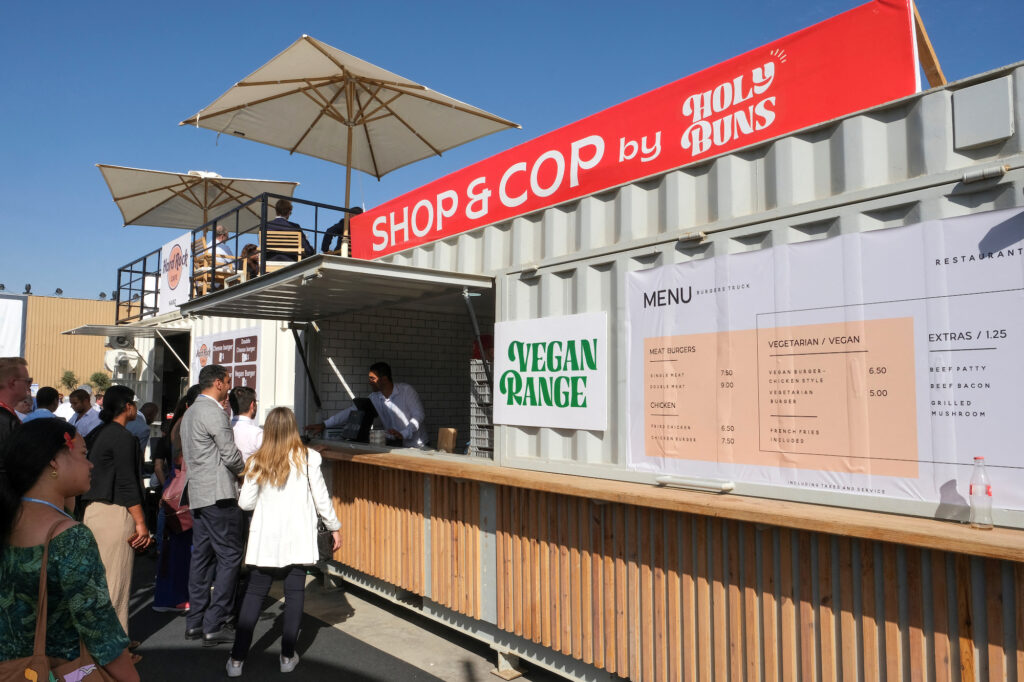Cutting meat and dairy output is not yet on the agenda for governments—many of which give billions of dollars to livestock farmers in subsidies
Sharm El-Sheikh, Egypt (Reuters) – On any morning at the COP27 climate conference, you can expect a gauntlet of anti-meat protesters wearing pig and cow costumes, holding banners decrying the carbon footprint of livestock, and chanting slogans like “Let’s be vegan, let’s be free.”
Activist groups and corporate startups have descended on the two-week climate summit in Egypt to heap pressure on the hundreds of global policymakers there over the world’s love affair with meat and its role in warming.
Their demands range from lowering meat consumption to policies as seemingly outlandish as transitioning to cell-based meat grown in steel vats, which could eliminate the need for feed crops, ranch land, and slaughterhouses.
Cows, sheep, pigs, and other livestock are responsible for about 20 percent of global greenhouse gas emissions, according to a peer-reviewed assessment led by researchers at the University of Illinois and published last year.
Cutting meat and dairy output is not yet on the agenda for governments—many of which give billions of dollars to livestock farmers in subsidies. Instead, they are advancing policies to reduce the emissions using feed additives that make animals less gassy, and technology that sucks up the methane wafting off manure heaps.
And researchers fear the impact may be greater, after recent efforts to measure emissions at individual US farms—by, say, flying a methane-detecting plane over them—showed them churning out much more than estimated.
“We seem to be wildly off. Virtually every time these… measurements are conducted they disagree with (official data),” said Matthew Hayek, a researcher at New York University.
Negotiators from nearly 200 countries at COP27 are holding discussions focused on the problem for the first time in the UN summit’s nearly three-decade history.
But cutting meat and dairy output is not yet on the agenda for governments—many of which give billions of dollars to livestock farmers in subsidies. Instead, they are advancing policies to reduce the emissions using feed additives that make animals less gassy, and technology that sucks up the methane wafting off manure heaps.

Activists aren’t buying it.
“This can never be the way to net zero,” said Max Weiss, a campaigner at the Plant Based Treaty, a global activist group promoting a meat-free diet.
“We have to move away from animal production.”
Climate scientists are also skeptical that industry-preferred measures will go far enough.
Andy Reisinger, a farm emissions specialist who is a vice-chair of the UN’s IPCC climate panel, said feed additives could worsen emissions by promoting intensive farming.
“It would result in more intensive livestock production that would require larger areas of land to produce the animal feed, putting pressure on forest land,” Reisinger told Reuters.
A report released on Tuesday by the Changing Markets Foundation, a sustainability advocacy group, showed the combined emissions from 15 of the world’s top meat and dairy companies exceeded those of Germany.
The other white meat
Anti-meat campaigners have been protesting food kiosks at the COP27 summit for selling burgers and chicken—foods they say don’t belong at a climate conference.
“When you enter the conference, you have the scent of grilled animal meat in your nose. Which is dystopian to me,” Weiss said.
But not everyone minds the smell of barbecue. That’s why several companies represented at the summit want to commercialize an emerging technology to grow real meat in steel vats using microbial fermentation.
“We think people want to eat meat,” said Josh Tetrick, the CEO of GOOD Meat, who was serving up his company’s cell-based chicken during an event on COP27’s sidelines. “We’re just trying to figure out a more climate-friendly way of giving them what they want.”
Their aim is to be able to provide steaks, chicken breasts, and pork without the downsides of traditional animal agriculture.
“We think people want to eat meat,” said Josh Tetrick, the CEO of GOOD Meat, who was serving up his company’s cell-based chicken during an event on COP27’s sidelines.
“We’re just trying to figure out a more climate-friendly way of giving them what they want.”
Tetrick’s company already sells small amounts of “cultivated chicken” to restaurants in Singapore and is investing in production capacity in the United States in a bet regulators will approve its sale there.
While the taste and texture are nearly identical to chicken, the financial cost is about 10 times higher. “We need to fix that,” Tetrick said.
Helena Wright, policy director at the FAIRR Initiative, an investor network focused on sustainable agriculture, said she was encouraged by the focus on food at COP27.
“The conversation has started. And regardless of whether governments act, the market is already shifting,” she said.
(Reporting by Richard Valdmanis and Tim Cocks; Editing by Frank Jack Daniel)